Discover 11 hidden attractions, cool sights, and unusual things to do in Sylt (Germany). Don't miss out on these must-see attractions: St. Severin, Denghoog, and Rotes Kliff lighthouse. Also, be sure to include Leuchtturm Kampen in your itinerary.
Below, you can find the list of the most amazing places you should visit in Sylt (Schleswig-Holstein).
Table of Contents
St. Severin

Evangelical church in Sylt, Germany. St. Severin is a Lutheran parish church in Keitum on the island of Sylt, northern Germany. It was named after the 4th-century bishop Severin of Cologne. Built in the Romanesque style and first documented in 1240, the church stands back from the town at a higher elevation. Tests have shown that the roof of the church can be dated to 1216, making it the oldest religious building in Schleswig-Holstein. The tower was built around 1450 and served as a navigation mark for seafarers as well as a prison.[1]
Address: Proestwai 20, 25980 Keitum
Denghoog
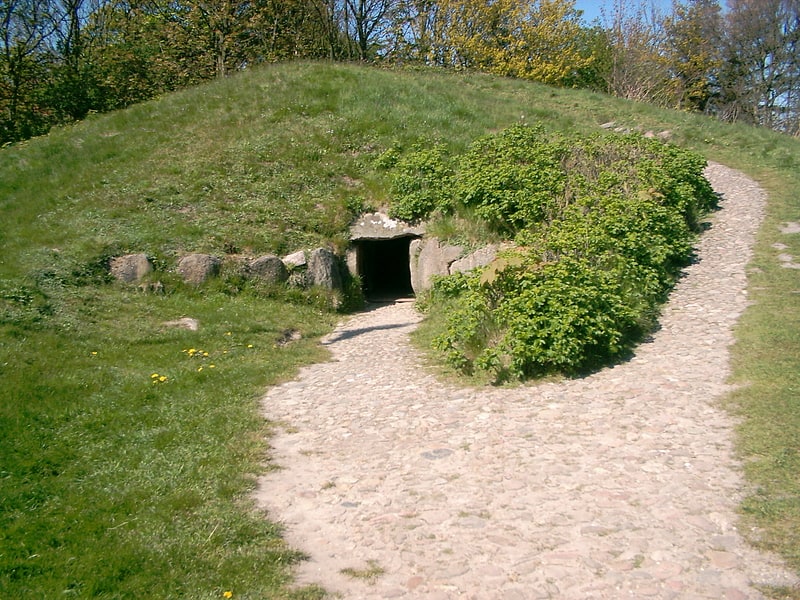
Historical landmark in Wenningstedt-Braderup, Germany. Denghoog is a Neolithic passage grave dating from around 3000 BC on the northern edge of Wenningstedt-Braderup on the German island of Sylt. The name Denghoog derives from the Söl'ring Deng and Hoog.[2]
Address: Am Denghoog 1, 25996 Wenningstedt-Braderup (Sylt)
Rotes Kliff lighthouse
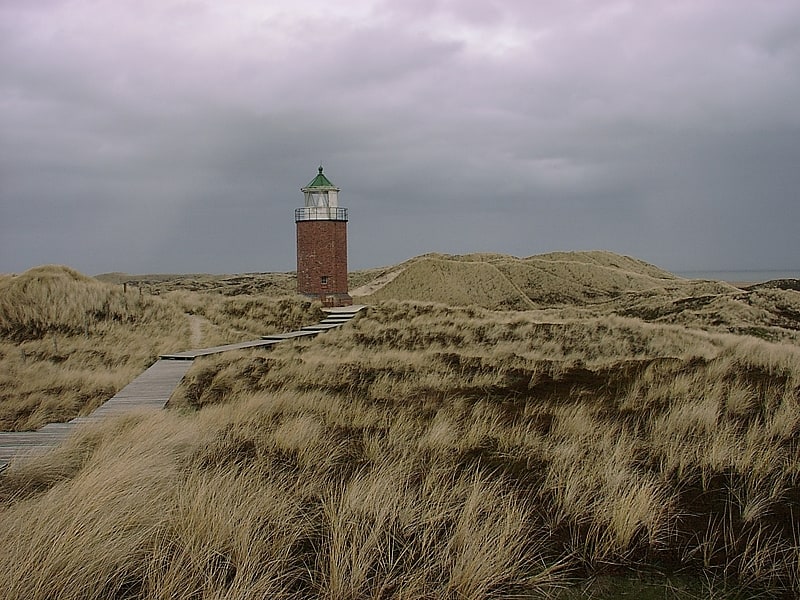
Also known as: Quermarkenfeuer Rotes Kliff
Lighthouse in Kampen, Germany. The Rotes Kliff Lighthouse on the island of Sylt, Germany, served as a sector light from 1913 to 1975. It is located on a cliffside north of the village of Kampen.[3]
Leuchtturm Kampen
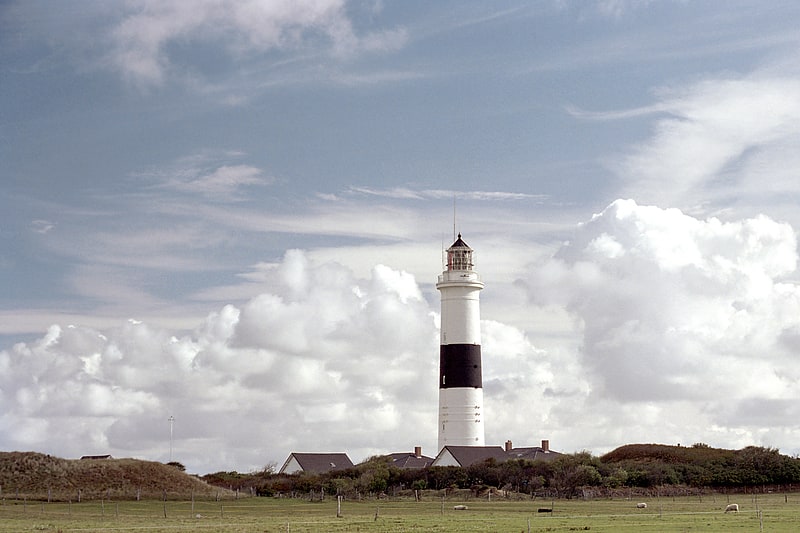
Lighthouse. The Kampen Lighthouse is located on the geestland core of the German island of Sylt, south of Kampen. It is a white conical stone tower with a broad black band.[4]
St. Niels

St. Niels is a Lutheran church in Westerland, a seaside resort on the German island of Sylt. Built in 1634 and consecrated in 1637 it is the city’s oldest building and home to a congregation within the Evangelical Lutheran Church in Northern Germany. The church is dedicated to Saint Nicholas, on Sylt called Niels.[5]
Address: 37 Kirchenweg, Sylt
Rantum Basin
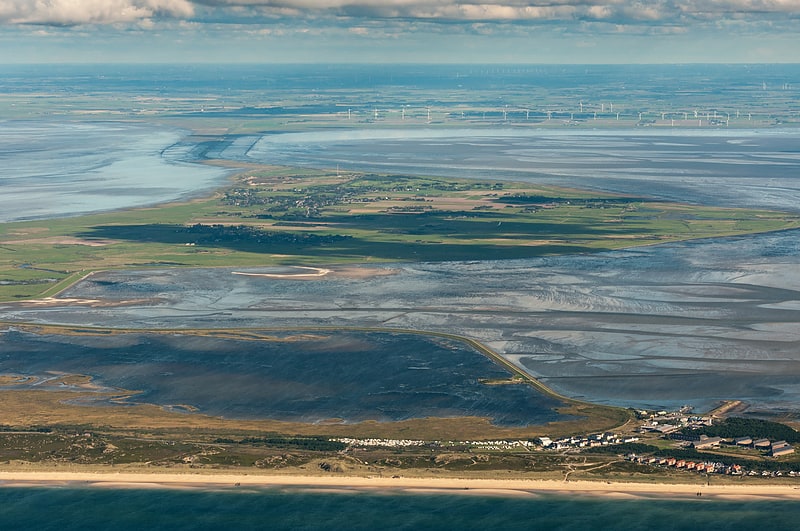
The Rantum Basin is a nature reserve located about in the middle of the island of Sylt, south of the towns of Westerland and Tinnum. It is named after the village of Rantum. This protected area is managed by the Jordsand association.
Rotes Kliff
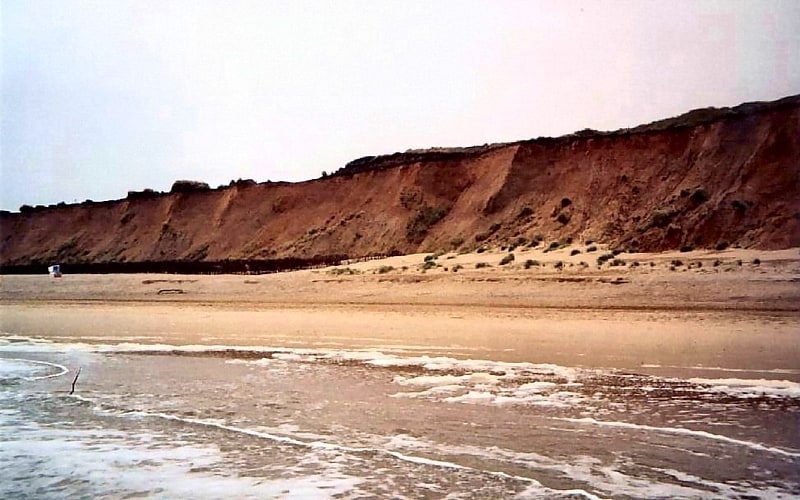
Disco club in Kampen, Germany. The Rotes Kliff is a around 30-metre high line of sea cliffs between the villages of Wenningstedt and Kampen on the German North Sea island of Sylt. It is located on the west side of the island facing the open sea, beginning in the south at the car park of "Risgap" in Wenningstedt and ending in the north at Haus Kliffende on the Kampen West Heath.
For centuries these striking cliffs have acted as an unmistakable recognition mark of the island for ships. Nowhere on the German and Dutch North Sea shores is there such a striking cliffed coast.
About 120,000 years ago, glaciers of the Saale glaciation deposited thick, unsorted rock debris in the region of the present-day island of Sylt. As a result of rising sea levels in the post-glacial period, these formed an abrasion coastline. The rusty-red glacial till, which gives the cliffs their name, is caused by colouration arising from the oxidation of ferrous elements.
Even in the 19th century, geologists suspected there was a geological connexion between Sylt and Heligoland, whose rocks have a similar coloration but are considerably older and have a different genesis. The rocks that break off the Rotes Kliff - such as flint, rhomb porphyry or Rapakivi granite - still enable an accurate determination of their origin to be made.
The Rotes Kliff has always been at great risk from storm surges and erosion. Since the end of the 1970s, coastal defence measures have been taken, however, in the shape of extensive sand replenishment of the entire west beach of the island and this has proved an important protection against the loss of land. However this has also resulted in the Rotes Kliff in the municipality of Wenningstedt becoming largely invisible from the sea, because it is now hidden behind beach grass-covered sand dunes.[6]
Uwe Düne
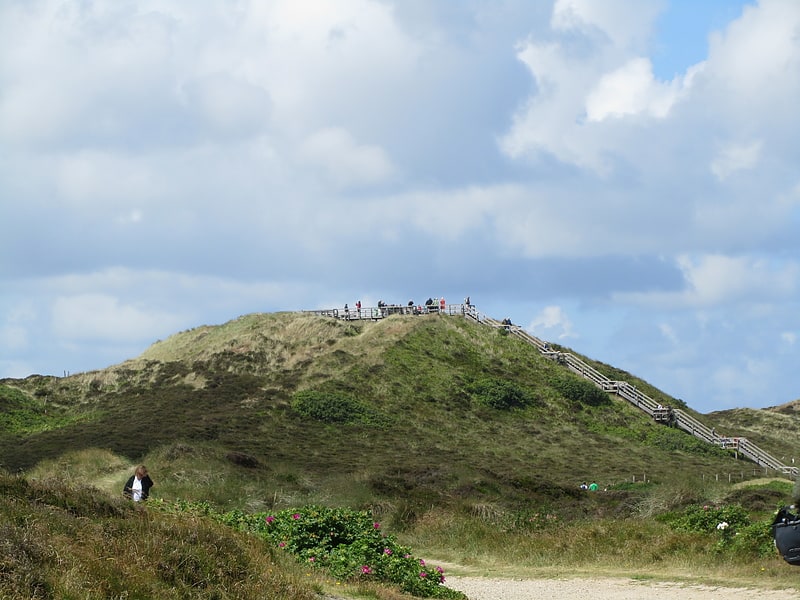
The Uwe Dune, also spelled Uwedüne or Uwe Düne, is the highest elevation of the German North Sea island of Sylt at 52.5 m above sea level and is not surpassed by any natural elevation within a radius of about 40 kilometers; Vongshøj, which lies northeast in Denmark, is the next highest neighbor at 62 m above sea level. Its geographical dominance thus clearly exceeds that of the Zugspitze.
The dune is located about 1 km west of the center of Kampen and about 300 m east of the Red Cliff. A wooden staircase with 110 steps has led to the viewing platform at its summit since the 1920s. The view encompasses large parts of the center and north of Sylt and, weather permitting, extends far out to sea, as far as the Danish North Sea island of Rømø and the German-Danish mainland.
The height of the 52.5 m high dune is sometimes given as only 50 m, which refers to a 50.2 m high point near the summit.
The dune is named after the jurist Uwe Jens Lornsen (1793-1838), a champion of a united and independent Schleswig-Holstein.
Harhoog
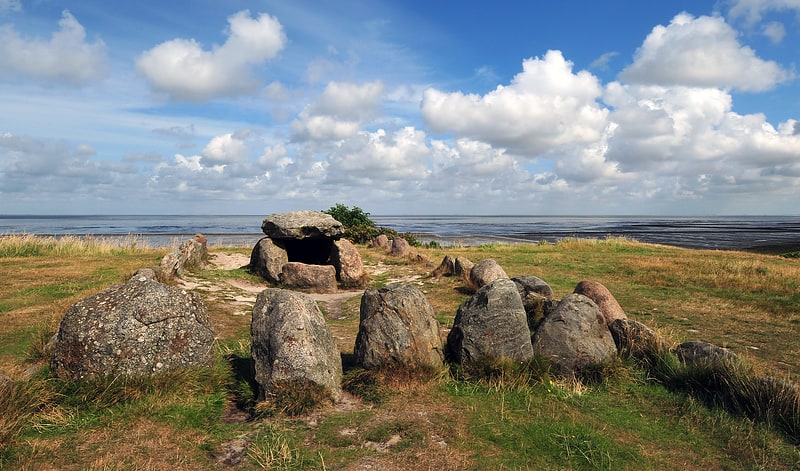
Historical landmark in Sylt, Germany. The Harhoog is a dolmen, a rectangular megalithic tomb from the Funnelbeaker culture, located near Keitum on the island of Sylt in Schleswig-Holstein, Germany. Discovered in 1925, it was moved to the present site in 1954 when a new airport was developed.[7]
Sylt Aquarium
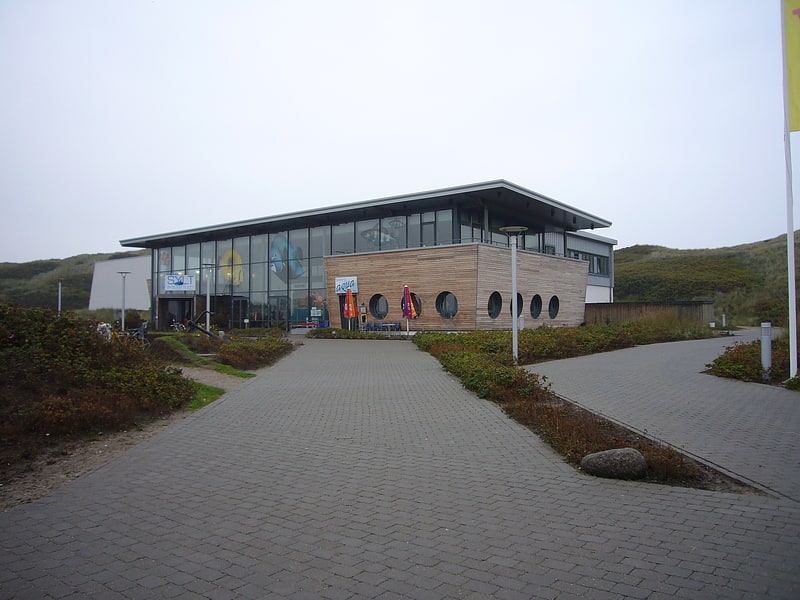
The Sylt Aquarium in the south of the town of Westerland on the island of Sylt is a zoological garden specializing in fish from the North Sea and tropical fish from coral reefs. Inaugurated in 2004, the aquarium is located directly on the dune belt and draws its fresh water from the North Sea through a direct pipeline. It features 25 saltwater tanks with about 2000 fish. It has a glass tunnel through which visitors can pass under a tank.
Address: Gaadt 33, 25980 Westerland
Rotes Kliff
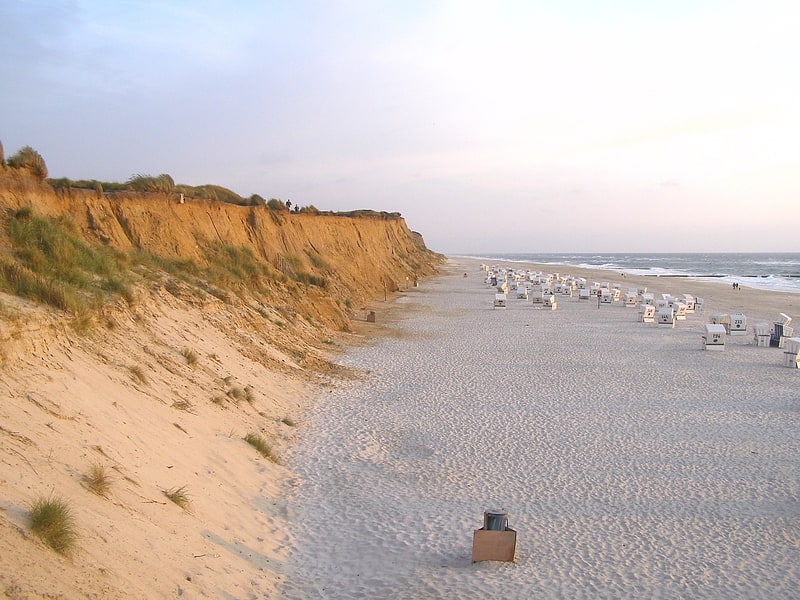
The Rotes Kliff is a around 30-metre high line of sea cliffs between the villages of Wenningstedt and Kampen on the German North Sea island of Sylt. It is located on the west side of the island facing the open sea, beginning in the south at the car park of "Risgap" in Wenningstedt and ending in the north at Haus Kliffende on the Kampen West Heath.
For centuries these striking cliffs have acted as an unmistakable recognition mark of the island for ships. Nowhere on the German and Dutch North Sea shores is there such a striking cliffed coast.
About 120,000 years ago, glaciers of the Saale glaciation deposited thick, unsorted rock debris in the region of the present-day island of Sylt. As a result of rising sea levels in the post-glacial period, these formed an abrasion coastline. The rusty-red glacial till, which gives the cliffs their name, is caused by colouration arising from the oxidation of ferrous elements.
Even in the 19th century, geologists suspected there was a geological connexion between Sylt and Heligoland, whose rocks have a similar coloration but are considerably older and have a different genesis. The rocks that break off the Rotes Kliff - such as flint, rhomb porphyry or Rapakivi granite - still enable an accurate determination of their origin to be made.
The Rotes Kliff has always been at great risk from storm surges and erosion. Since the end of the 1970s, coastal defence measures have been taken, however, in the shape of extensive sand replenishment of the entire west beach of the island and this has proved an important protection against the loss of land. However this has also resulted in the Rotes Kliff in the municipality of Wenningstedt becoming largely invisible from the sea, because it is now hidden behind beach grass-covered sand dunes.[8]
Address: Riperstieg 333C, 25999 Kampen (Sylt)